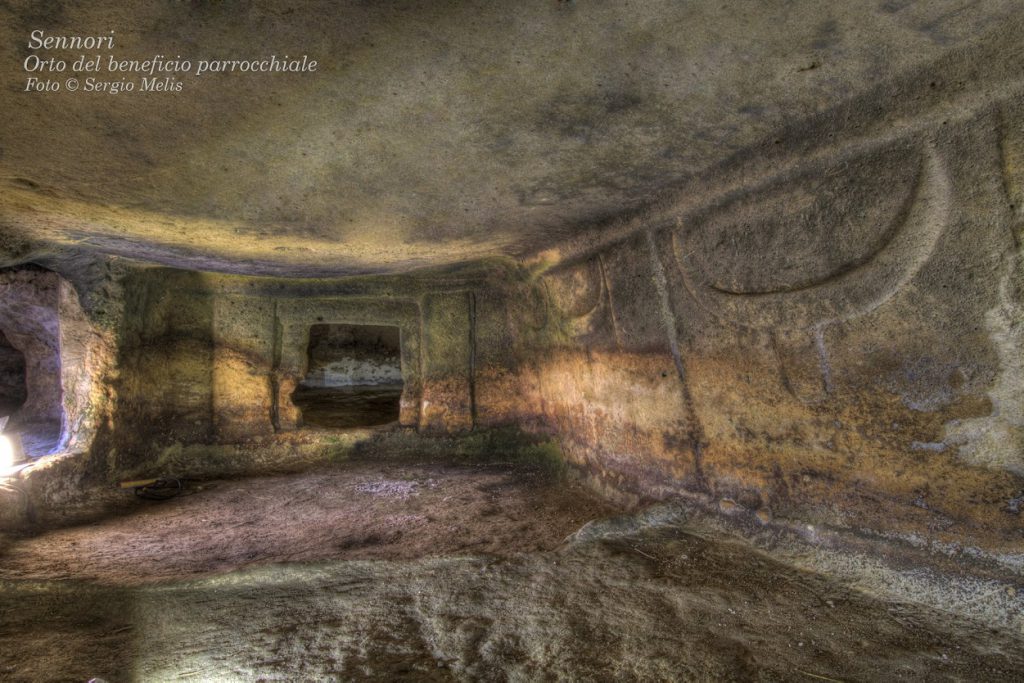Domus De Janas Of Sennori 0 Comments

Sennori’s Domus de Janas could be a UNESCO heritage site, being on the list for candidacy as a UNESCO World Heritage Site for The decorated Domus de Janas of Sardinia.
The church of San Basilio Magno, 1 hour and 45 minutes, 136 km far from Gabbiano Azzurro Hotel & Suites, is located in Sennori. Built in the 14th century, it was then restored and enlarged from 1945 to 1958, changing its style from Romanesque to Aragonese Gothic. Inside there is a large sixteenth-century altarpiece from the Cagliari school which portrays the Virgin’s coronation.
In the immediate vicinity of the church, on a territory under its jurisdiction, there is a small, very precious pre-Nuragic necropolis known as the "Domus de Janas of the parish benefit garden".
The project envisaged necessary interventions to ensure that the "Domus de Janas of the parish garden" became suitable for the candidacy, a place accessible to all and therefore attractive to tourist visits with walkways, footpaths, parapets and everything necessary to visit.
The "Domus de Janas of the parish benefit garden" are hypogeal (underground) tombs, imputable to the Ozieri culture (3500 - 2700 BC), they are dug into a limestone outcrop, including 11 rooms connected to each other. The first nucleus, the oldest, has a "T" layout and includes three rooms. The second, which was accessed via a dromos (corridor), consists of a main cell to which several intermediate rooms open. In a cell called the " The Protomes’ Room", figures of great value of bull protomes (in ancient art, the protome is a decorative element consisting of the head, sometimes also with part of the bust, of a human or animalistic figure or fantastic) appear.
We have already found other protomes here in the blog, for example in the Necropolis Of Su Crucifissu Mannu (Porto Torres), in the necropolis of Monte d’Accoddi (Sassari), in Castelsardo (in the famous Roccia dell'Elefante, etc.
Man’s presence in the Sennori territory can be found starting from the Neolithic as confirmed by the archaeological site " Domus de Janas of the parish benefit garden". During the Nuragic period the territory of Sennori was heavily inhabited as evidenced by the site of Su Nuraghe, the Nuraghe of Badde Margherita, the Nuraghe of Badde Puttu, the Nuraghe of San Biagio and the Tomb of the Giants of Oridda.
While the Punic period is practically missing, the Roman period has a rich documentation, so much so that the historical region of Romangia, in which Sennori is located, was probably founded by the Romans, taking its name from Romania, that is the lands conquered by Rome, in antithesis to Barbaria or Barbagia, meaning those lands that they failed to conquer and therefore remained populated by "barbarians".
Sennori was subsequently part of the Judicate of Torres or Logudoro, then became part of the Sassari republic in 1294. The Aragonese arrived and established the fiefdom of Sennori in the Romangia area. In 1440 all Romangia’s fiefdoms ended up in the hands of Baron Gonario Gambella. Writer Enrico Costa wrote about his niece Rosa Gambella, baroness and vice-queen of Sardinia in the famous novel titled after her name.
In 1839, with the abolition of the feudal system, Sennori was redeemed to the "Amat of San Filippo", to become an autonomous municipality governed by a major and a municipal council.
“Archaeological sites are a non-renewable resource; once they are destroyed, the information they contained is lost forever.” (Anonymous)
--Written by Daniela Toti
Photo by Sergio Melis
Teilen Sie uns Ihre Meinung mit!